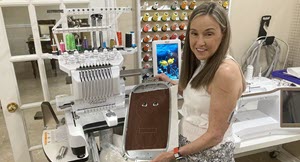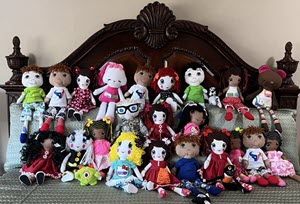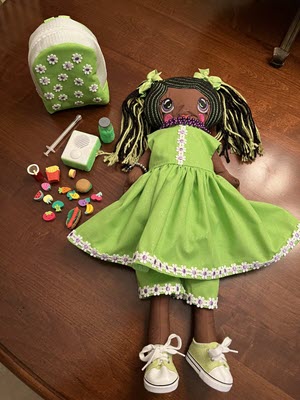By David Brown, 1LT, Texas State Guard
 HUMBLE, Texas - Though her husband often has to be away for his work in the Texas State Guard, one might well find Celia Levesque at home in Humble at her sewing machine, busy making dolls to give to kids with diabetes. Not just any dolls, mind you, but dolls with special needs like their soon-to-be “parents”.
HUMBLE, Texas - Though her husband often has to be away for his work in the Texas State Guard, one might well find Celia Levesque at home in Humble at her sewing machine, busy making dolls to give to kids with diabetes. Not just any dolls, mind you, but dolls with special needs like their soon-to-be “parents”.
“(Diabetes is) such a devastating disease, and it requires every minute of every day–there’s no vacations or time off–and so you’re either checking your blood sugar, you’re eating something, you’re changing something out,” Levesque says. She knows first hand, as a person with Type 1 diabetes, herself. Years ago, while volunteering to help a group of young children at the American Diabetes Association’s ‘Camp Rainbow’ in Houston, Levesque recalls bringing in a ‘Jerry the Bear’ doll, designed to appear as if he has Type 1 diabetes.
“It had a little computer on his tummy and everything (to ‘check blood sugar’ levels), and you could feed Jerry, give him insulin and give him a pump and everything… and those kids fought over him the whole time, ‘Oh, I want to feed Jerry and give Jerry insulin’ and that sort of thing. So at the end of the camp, one girl was in tears when she had to leave camp because she didn’t want to leave Jerry behind.”
It inspired Levesque (who also works as a nurse practitioner at MD Anderson Cancer Center in Houston treating kids with diabetes who have cancer) to begin making dolls to give to the children. “The next year,” Levesque says, “I purchased some basic unclothed dolls with faces and hair, and I made clothes for them. I hadn’t sewn since college, so I got an inexpensive sewing machine and made that first batch. Then the next year, I found they’d stopped making the basic dolls with faces and hair so I decided to make my own dolls from scratch. I bought an embroidering machine to stitch out the faces, and I put the hair on them and made up the clothes. Then I learned how to make doll backpacks, so inside the backpacks kids would get a plastic vial with sparkle glitter on it (to represent insulin), and I’d buy syringes with no needles, and would embroider little insulin pumps and glucose monitors, and would put on velcro to attach the backpacks to the dolls. I knew (the camp kids) all needed their own dolls.”
As comforting and cute as the dolls are, there’s an educational component, as well.
 “For food, at first I used pieces of foam, but then I found erasers shaped like food. And for the meter (which measures blood sugar), I found a little recording speaker device that looks a bit like a meter, decorated it, and loaded sounds on them so that when you press the button, the child hears whether to feed their dolly, check their blood sugar and that sort of thing. So the kids get to learn that sugars go up, sugars go down–no judgment about ‘good’ or ‘bad– and when it comes to food they have healthy choices and a little junk food, too. The idea is to add a little education there and they get to take the dolls home with them. They also get a coloring page to put the name of their doll on.”
“For food, at first I used pieces of foam, but then I found erasers shaped like food. And for the meter (which measures blood sugar), I found a little recording speaker device that looks a bit like a meter, decorated it, and loaded sounds on them so that when you press the button, the child hears whether to feed their dolly, check their blood sugar and that sort of thing. So the kids get to learn that sugars go up, sugars go down–no judgment about ‘good’ or ‘bad– and when it comes to food they have healthy choices and a little junk food, too. The idea is to add a little education there and they get to take the dolls home with them. They also get a coloring page to put the name of their doll on.”
Since she first began giving away dolls to kids at the Rainbow Camp seven years ago, Levesque says she has no idea how many dolls she’s made and given out - “several hundred, I guess.” Last year Levesque made and distributed 50 dolls; for this year’s Camp Rainbow, she’s already made 30, with more on the way so that she has a variety of ‘boy’ and ‘girl’ dolls with different skin tones, hair colors, and, now, bunnies and bears, too.
If these dolls sound a bit like those expensive ‘Care Bears’ or ‘Build-A-Bears’, you’re on to something, only Levesque doesn’t charge a penny for her handmade dolls. This, despite the fact that the embroidering machines alone were purchased at an enormous personal cost, to say nothing of the rest of the fabric materials needed, the time spent planning, designing, and stitching the tiny bodies and costumes, preparing the miniature recorder/speaker devices and the programming software, and the countless hours of sewing involved. All of it done with love.
The West Texas native reckons each doll takes about 18 hours to make from start to finish, though typically Levesque will try to do multiple dolls in batches, cutting out fabric for several at once, stitching up multiple arms and legs in one sitting, little steps that make assembling the dolls more efficient.
But Levesque says she sometimes does one-off dolls for kids who’ve been newly diagnosed, or for diabetes educators when asked. Again, free of charge. “Now if someone wants to donate some material, I won’t say no,” she adds with a smile.
 Levesque’s spirit of public service seems to run in the family. Her husband, Col. Arthur Levesque, is in the Texas State Guard Training Center of the Texas State Guard and also serves with the local unit of the Civil Air Patrol (CAP) near Houston. “We often talk about the support we get from our spouses to work with the Texas State Guard,” Col. Levesque says. “I would like to think that I have encouraged and supported her desire to make a positive impact on little children with diabetes.”
Levesque’s spirit of public service seems to run in the family. Her husband, Col. Arthur Levesque, is in the Texas State Guard Training Center of the Texas State Guard and also serves with the local unit of the Civil Air Patrol (CAP) near Houston. “We often talk about the support we get from our spouses to work with the Texas State Guard,” Col. Levesque says. “I would like to think that I have encouraged and supported her desire to make a positive impact on little children with diabetes.”
In addition to her work with the diabetes camp, Celia Levesque also does volunteer work through her church (Second Baptist Church in Kingwood), helping to feed the hungry during the holidays, and distributing toys to underprivileged children at Christmas.
April is National Volunteer Month. "In the Texas State Guard, service members selflessly volunteer their time and expertise to help their fellow Texans during emergencies and disasters,” says Maj. Gen. Anthony Woods, Commanding General of the Texas State Guard, “but we often find that the families of service members give to their communities in other ways that are just as important. Though they may not be wearing the uniform, their volunteerism is vital, and inspiring to us all.”
For Celia Levesque, volunteering is a calling, clearly inspired by faith. “I’ve been so blessed to have a good job, to live in a country where I have health care… I’m doing what God wants me do to–and I just feel that I should give back.
The Texas State Guard salutes those who are serving their communities in a variety of different ways. Since World War Two, tens of thousands of men and women have chosen to serve their fellow Texans by joining the ranks of the Texas State Guard. Information about opportunities in the nation’s premier State Guard force can be found online at tmd.texas.gov/state-guard.